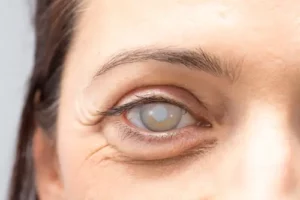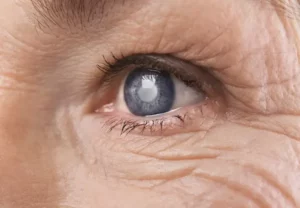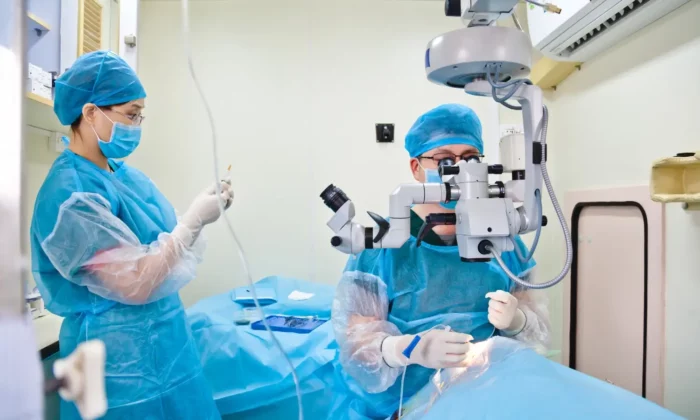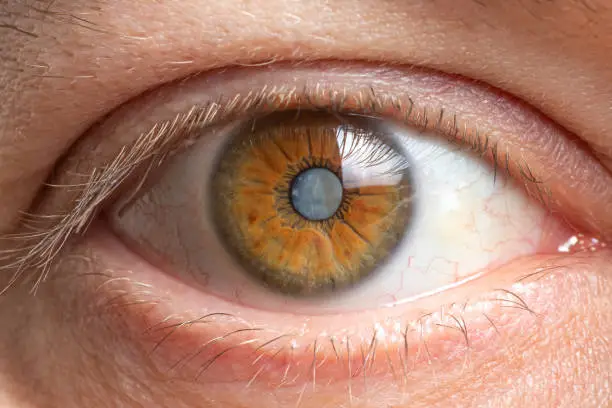Imagine you’re immersed in your favorite book or enjoying a vibrant sunset, but something feels off. The once vivid colors now seem muted, and your vision isn’t as clear as it used to be. It’s disconcerting, even a bit unsettling. Is it just temporary fatigue, or could it be something more? Enter the world of brown cataracts—a condition that might just be the answer to the changes you’re experiencing. If you’ve ever wondered about those subtle shifts in your vision or the unexpected dullness in colors, this guide is your starting point. Dive in to understand the intricacies of brown cataracts, its causes, symptoms, and the paths to treatment.
Contents
Brown Cataracts Defined: What It Is and Its Origins
 A cataract refers to the clouding of the lens inside the eye, leading to vision changes. Brown cataract, specifically, is a type of age-related cataract characterized by the browning or yellowing of the eye’s natural lens. This discoloration not only affects clarity but can also cause a noticeable reduction in the perception of blue colors, making them appear more muted. While there are various types of cataracts – nuclear, cortical, and posterior subcapsular – it’s the brown or brunescence of the nuclear cataract that stands out due to its distinct coloration and the unique visual challenges it presents.
A cataract refers to the clouding of the lens inside the eye, leading to vision changes. Brown cataract, specifically, is a type of age-related cataract characterized by the browning or yellowing of the eye’s natural lens. This discoloration not only affects clarity but can also cause a noticeable reduction in the perception of blue colors, making them appear more muted. While there are various types of cataracts – nuclear, cortical, and posterior subcapsular – it’s the brown or brunescence of the nuclear cataract that stands out due to its distinct coloration and the unique visual challenges it presents.
Origins of Brown Cataract
The onset of brown cataracts, like other cataracts, is multifaceted, with various contributing factors:
- Age: The most significant factor is aging. As we grow older, natural changes in the lens can lead to its yellowing or browning.
- Genetics: Familial predispositions can play a role. If family members have had cataracts, especially at a younger age, the chances of developing them might be higher.
- Environmental Factors: Prolonged exposure to ultraviolet (UV) light from the sun can accelerate the process, making sunglasses with UV protection crucial.
- Health Conditions: Diseases like diabetes or specific eye conditions can increase the risk. Additionally, certain medications, especially steroids, can hasten the onset.
- Lifestyle Choices: Smoking and excessive alcohol consumption have been linked to the earlier development of cataracts, including the brown variety.
Understanding the nature and origins of brown cataracts sets the foundation for recognizing its early signs and seeking timely intervention. Armed with knowledge, one can navigate the journey from diagnosis to treatment with clarity and confidence.
Symptoms to Watch For
 Brown cataracts, like other cataract types, begin subtly, often unnoticed in their early stages. But as they progress, the symptoms become more pronounced, affecting daily activities and overall quality of life. Recognizing these early signs is crucial for timely diagnosis and intervention. Here are the typical symptoms associated with brown cataracts:
Brown cataracts, like other cataract types, begin subtly, often unnoticed in their early stages. But as they progress, the symptoms become more pronounced, affecting daily activities and overall quality of life. Recognizing these early signs is crucial for timely diagnosis and intervention. Here are the typical symptoms associated with brown cataracts:
- Blurred or Clouded Vision: One of the primary indications is a gradual decline in clarity. It’s akin to looking through a dusty window or a foggy piece of glass.
- Muted Colors: Particularly, a noticeable reduction in the perception of blue shades. Blues may appear greener, and the world might seem to have a brownish or yellowish tint.
- Increased Sensitivity to Light: Bright lights, especially during nighttime driving, might cause discomfort. Halos might appear around light sources, causing distractions.
- Difficulty in Low-Light Conditions: Activities like reading or identifying faces in dimly lit environments become challenging.
- Frequent Prescription Changes: A rapid change in eyeglass or contact lens prescription might be a hint, especially if these changes don’t bring about the expected clarity.
- Double Vision: In the early stages of cataract development, one might experience a temporary double vision or multiple images in one eye.
- Glare and Reduced Contrast: Bright colors might seem glaring, and there might be a noticeable reduction in contrast, making it hard to distinguish between similar shades.
Recognizing the early signs of brown cataracts and seeking expert advice can pave the way for effective treatment and restored vision.
Stages of Brown Cataracts Progression
Brown cataract, like all medical conditions, doesn’t manifest overnight. It develops and progresses through distinct stages over time. Understanding these stages can help in timely detection and effective management. Here’s an outline of its progression:
Early Stage (Initial Onset)
- Severity: At this point, the cataract is just beginning to form. The changes in vision might be minimal and often go unnoticed.
- Visual Implications: Minor blurring of vision and slightly reduced night vision might be the only noticeable symptoms. Many people might not even feel the need for any medical intervention at this stage.
Intermediate Stage (Progressing)
- Severity: The cataract starts to grow and become denser. There’s a noticeable impact on daily activities that rely on clear vision.
- Visual Implications: Colors, especially blues, begin to appear muted. There might be an increased sensitivity to light, frequent changes in prescription glasses, and the beginning of the characteristic yellow or brown tinge in vision.
Advanced Stage (Mature Cataract)
- Severity: The lens becomes significantly clouded, and vision impairment is more profound.
- Visual Implications: Daily tasks like reading, driving, or recognizing faces become challenging. Glare becomes more pronounced, especially during nighttime. The brown or yellow tint to vision is distinct, making color differentiation difficult.
Hyper-mature Stage (Overripe Cataract)
- Severity: If left untreated, the cataract can reach a stage where the lens becomes overly dense and might even start to leak fluid, causing inflammation.
- Visual Implications: Vision is severely obstructed, almost like looking through a frosted window. There’s a significant reduction in visual acuity, and daily tasks become nearly impossible without assistance.
It’s crucial to emphasize that timely intervention, especially during the early and intermediate stages, can lead to better treatment outcomes. If you notice any changes in vision or have been diagnosed with a cataract, regular follow-ups with an ophthalmologist can help monitor its progression and decide the best course of action.
Treatment Options Available

Addressing brown cataracts, like other types, hinges on the stage of its progression and the level of vision impairment. While early stages might not require immediate surgical intervention, advanced cataracts often necessitate more direct measures. Here’s a breakdown of the available treatment options:
Non-Surgical Interventions
- Eyeglasses or Contact Lenses: In the early stages, a change in prescription might suffice to enhance visual clarity.
- Magnifying Lenses: For reading or detailed tasks, magnifying glasses can provide temporary relief.
- Improved Lighting: Ensuring well-lit environments can help, especially in dim conditions.
- UV Protection: Sunglasses that block UV rays can help slow down cataract progression.
Surgical Procedures
- Phacoemulsification: The most common procedure where an ultrasonic device breaks the cloudy lens into small fragments, which are then removed. A new artificial lens replaces the old lens.
- Extracapsular Cataract Extraction: Used for advanced cataracts, this procedure involves removing the cloudy part of the lens in one piece and replacing it with an artificial lens.
- Intracapsular Cataract Extraction: A rarer procedure where the entire lens, including its capsule, is removed, followed by the placement of an artificial lens.
It’s essential to consult with an ophthalmologist to determine the best treatment option tailored to individual needs. With advancements in medical technology, tackling brown cataracts has become safer and more effective, offering patients a renewed perspective on the world around them.
Prevention and Eye Care Tips
While some factors, like age and genetics, are beyond our control, there are several proactive measures one can take to potentially delay the onset or progression of brown cataracts. Prioritizing eye health through simple daily practices can make a considerable difference. Here’s a guide to help protect those invaluable windows to the world:
- Regular Eye Examinations: Schedule routine check-ups with your ophthalmologist to detect early signs of cataracts and monitor its progression, ensuring timely interventions when needed.
- Protective Eyewear: Always wear sunglasses with 100% UV protection when outside. This shields the eyes from harmful ultraviolet rays which can accelerate cataract formation.
- Dietary Habits: Incorporate antioxidant-rich foods in your diet. Leafy greens, berries, and citrus fruits are packed with vitamins C and E that promote eye health. Additionally, Omega-3 fatty acids, found in fish like salmon and tuna, may also help prevent cataracts.
- Avoid Smoking: Smoking produces free radicals, which can speed up the development of cataracts. Quitting smoking, or better yet, never starting, can reduce this risk.
- Limit Alcohol Consumption: Excessive alcohol intake can increase the chances of developing cataracts. It’s advisable to drink in moderation.
- Manage Health Conditions: Regularly monitor and control conditions like diabetes, which can increase the risk of cataracts. Adhering to prescribed treatments and medications is vital.
- Reduce Screen Time: Prolonged exposure to digital screens can strain the eyes. Adopt the 20-20-20 rule: every 20 minutes, take a 20-second break and look at something 20 feet away.
By integrating these preventive measures into your daily life, you’re not just warding off cataracts but ensuring overall eye health. Remember, the eyes are one of the most vital organs, deserving of care and attention. Prioritize them, and they’ll reward you with clear, vibrant visions of the world.
Conclusion
Our vision is one of life’s most invaluable gifts, allowing us to witness the world’s beauty, communicate, and navigate our surroundings. Cataracts, particularly brown cataracts, can cloud this gift, impacting daily life and experiences. The good news is that with today’s medical advancements, there’s hope and effective solutions available. Early detection, timely interventions, and proactive eye care are the keys to preserving and reclaiming the clarity of vision. If you’re experiencing cataract related problems, Cataract Surgery at EyeMantra can help: Book your free appointment now at 9711116605



